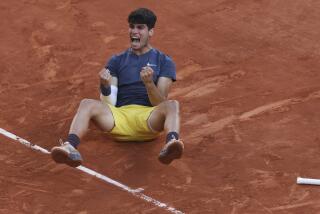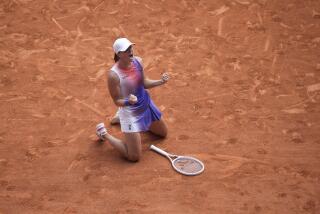French Finals Worth Cherishing
- Share via
PARIS — Reflections on the Grand Slam tournament that might have saved tennis, now that the last tear has been shed, the last embrace shared and the last mark in the clay checked . . .
Best winner (tie): How could you possibly decide between Andre Agassi and Steffi Graf?
Graf did not play here last year, and Agassi barely did, exiting in a first-round loss to Marat Safin. Agassi nearly withdrew this year because of a nagging shoulder injury. Graf was advised by some associates not to play because an injury would mar her Wimbledon chances.
They showed up and produced twin miracles. Graf had not won a Grand Slam event since the 1996 U.S. Open, and Agassi’s last one was the 1995 Australian Open. She did it the hard way--surviving a host of injuries this year--and went through the best in women’s tennis, defeating No. 2-ranked Lindsay Davenport, No. 3 Monica Seles and No. 1 Martina Hingis in the final three rounds.
With 22 Grand Slam titles, Graf is within two of the legendary all-time leader Margaret Court, who, fittingly, was on hand to present the trophy Saturday. The moment, the day, so moved Graf that she spontaneously declared this was her final French Open.
Like Graf, Agassi’s survival skills were unmatched on the men’s side. He went four sets in the first round against promising young clay-courter Franco Squillari of Argentina, and was within two points of elimination in his match with Arnaud Clement of France. His biggest test, before the final, was in the fourth round against defending champion Carlos Moya of Spain.
Mixing skill, guile and power, Agassi rallied from a 6-4, 4-1 deficit and had Moya muttering to himself, unable to recover his form. No wonder Agassi’s coach, Brad Gilbert, said after the final that his guy had nothing on Houdini.
In the final, Agassi recovered from a nightmarish first two sets and a rain delay. He became only the fifth player at Roland Garros to rally from a two-set deficit, and second in the open era. The other was Ivan Lendl in the 1984 final against John McEnroe.
Apparently, history also was on Agassi’s side. Only one player had lost in three finals here, Jaroslav Drobny in 1946, 1948 and 1950. With the victory, Agassi joined Rod Laver, Roy Emerson, Fred Perry and Don Budge as the only players to have won all four Grand Slam events.
Now that Agassi has ridden to the rescue of men’s tennis, maybe there will be a positive impact on Pete Sampras, providing the slumping former No. 1 a worthy adversary for the first time in years.
Best runner-up: Andrei Medvedev of Ukraine would have been a worthy champion as well. He was the epitome of class after the most disappointing of losses in his first Grand Slam final.
The sassy, brassy teens of the World Tennis Assn. tour should be ordered to watch a tape of his postmatch behavior. Despite having lost a heartbreaker--he won the first two sets in convincing fashion--he crossed over to Agassi’s side of the net and hugged him, and they hugged again on the victory stand.
Medvedev, as he had the entire tournament, charmed everyone on the premises, praising Agassi and thanking everyone else. At No. 100, he was the lowest-ranked French finalist in the Open era, and got there with victories over Sampras and Gustavo Kuerten.
Not only did he get his tennis game back, he got the girl.
Medvedev spoke openly about his love for tennis player Anke Huber, how the renewed relationship made him the “happiest man in the world.” He even joked about erroneous media reports about his supposedly impending wedding, telling this story:
“You know, people are calling me from Kiev and saying, ‘Congratulations. Not with your game.’ ”
“ ‘With what?’ ”
“ ‘You’re getting married.’ ”
“ ‘Really? That’s nice.’ ”
“Believe me, just so you know, when--let’s say if--we get married you all will know in advance, so you can prepare your presents.”
ANATOMY OF A MELTDOWN
The sight of Hingis unraveling on Court Central in a spasm of 18-year-old petulance against the dignified Graf was not a pretty one. And the international reviews were damning.
“Steffi Graf behaved like a champion and was made to feel like Suzanne Lenglen,” wrote the Independent, a British newspaper. “Martina Hingis . . . threw the rattle out of the pram, and was made to feel like Marie Antoinette.”
If anything, it was Hingis’ accumulated acts that turned the crowd against her. There were the racket breaking, the questioning of calls, the crossing over to Graf’s side of the net to argue a call, the underhand serves on match points, climbing up on the umpire’s chair to complain about crowd noise . . .
Graf could not believe what was happening. She soon tired of the sideshow, merely wanting to get on with it. Hingis returned to the court for the awards ceremony only at the behest of her mother.
Her sobs and speech in French stopped the crowd’s derision, but whatever redemption Hingis accomplished was undone in the interview room, where she kept saying how everyone had told her she was better than Graf.
In addition, French Open tournament referee Gilbert Ysern and WTA Chief Executive Officer Bart McGuire are reviewing television footage of an alleged altercation between Hingis and a WTA media staff member.
The incident, before the awards ceremony, was described by one official as something that occurred “in the heat of the moment.”
“Whatever we do, we want to make sure it is not a knee-jerk reaction,” said Joe Favorito of the WTA on Tuesday.
If Ysern believes the matter merits action, the Grand Slam Committee can issue a fine, a suspension or both. The WTA can fine a player as well.
More to Read
Go beyond the scoreboard
Get the latest on L.A.'s teams in the daily Sports Report newsletter.
You may occasionally receive promotional content from the Los Angeles Times.











